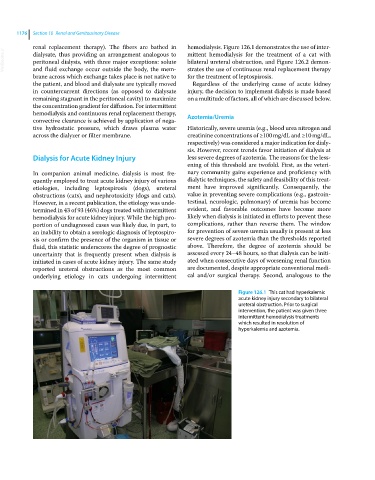Page 1238 - Clinical Small Animal Internal Medicine
P. 1238
1176 Section 10 Renal and Genitourinary Disease
renal replacement therapy). The fibers are bathed in hemodialysis. Figure 126.1 demonstrates the use of inter-
VetBooks.ir dialysate, thus providing an arrangement analogous to mittent hemodialysis for the treatment of a cat with
bilateral ureteral obstruction, and Figure 126.2 demon-
peritoneal dialysis, with three major exceptions: solute
and fluid exchange occur outside the body, the mem-
for the treatment of leptospirosis.
brane across which exchange takes place is not native to strates the use of continuous renal replacement therapy
the patient, and blood and dialysate are typically moved Regardless of the underlying cause of acute kidney
in countercurrent directions (as opposed to dialysate injury, the decision to implement dialysis is made based
remaining stagnant in the peritoneal cavity) to maximize on a multitude of factors, all of which are discussed below.
the concentration gradient for diffusion. For intermittent
hemodialysis and continuous renal replacement therapy, Azotemia/Uremia
convective clearance is achieved by application of nega-
tive hydrostatic pressure, which draws plasma water Historically, severe uremia (e.g., blood urea nitrogen and
across the dialyzer or filter membrane. creatinine concentrations of ≥100 mg/dL and ≥10 mg/dL,
respectively) was considered a major indication for dialy-
sis. However, recent trends favor initiation of dialysis at
Dialysis for Acute Kidney Injury less severe degrees of azotemia. The reasons for the less-
ening of this threshold are twofold. First, as the veteri-
In companion animal medicine, dialysis is most fre- nary community gains experience and proficiency with
quently employed to treat acute kidney injury of various dialytic techniques, the safety and feasibility of this treat-
etiologies, including leptospirosis (dogs), ureteral ment have improved significantly. Consequently, the
obstructions (cats), and nephrotoxicity (dogs and cats). value in preventing severe complications (e.g., gastroin-
However, in a recent publication, the etiology was unde- testinal, neurologic, pulmonary) of uremia has become
termined in 43 of 93 (46%) dogs treated with intermittent evident, and favorable outcomes have become more
hemodialysis for acute kidney injury. While the high pro- likely when dialysis is initiated in efforts to prevent these
portion of undiagnosed cases was likely due, in part, to complications, rather than reverse them. The window
an inability to obtain a serologic diagnosis of leptospiro- for prevention of severe uremia usually is present at less
sis or confirm the presence of the organism in tissue or severe degrees of azotemia than the thresholds reported
fluid, this statistic underscores the degree of prognostic above. Therefore, the degree of azotemia should be
uncertainty that is frequently present when dialysis is assessed every 24–48 hours, so that dialysis can be initi-
initiated in cases of acute kidney injury. The same study ated when consecutive days of worsening renal function
reported ureteral obstructions as the most common are documented, despite appropriate conventional medi-
underlying etiology in cats undergoing intermittent cal and/or surgical therapy. Second, analogous to the
Figure 126.1 This cat had hyperkalemic
acute kidney injury secondary to bilateral
ureteral obstruction. Prior to surgical
intervention, the patient was given three
intermittent hemodialysis treatments
which resulted in resolution of
hyperkalemia and azotemia.

